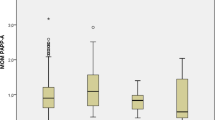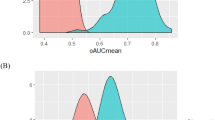Abstract
In our search for early biomarkers for the pregnancy complicationssmall for gestational age (SGA) and preeclampsia (PE) we analysed plasma from 19-21 weeks gestation in women recruited into the SCOPE study, a prospective cohort of nulliparous women, by differential in gel electrophoresis (DIGE). DIGE revealed the differential expression of clusterin levels and its isoforms in top6-depleted plasma of women who delivered an SGA infant but remained normotensive (SGA-NT; N = 8) compared to healthy women with an uncomplicated pregnancy outcome (Controls, N = 8). Immunosorbent enzyme-linked assay (ELISA) showed that compared to plasma clusterin levels from healthy controls [71.1 (SD 12.4) µg/mL, n = 39], clusterin was decreased in SGA-NT [58.3 (SD 11.7), N = 20, P < 0.0001], increased in women with SGA and PE [81.5 (SD 14.8), N = 20, P < 0.01], but similar in PE alone [71.2 (SD 9.4)g/ml, P = 1.0]. Screening for clusterin levels and/or its different isoformsmay be useful in mid-pregnancy to identify women who subsequently develop SGA but remain normotensive or who develop preeclampsia with SGA.
Similar content being viewed by others
References
McCormick MC. The contribution of low birth weight to infant mortality and childhood morbidity. N Engl J Med. 1985;312(2): 82–90.
McCowan LME, Roberts CT, Dekker GA, et al; SCOPE consortium. Risk factors for small-for-gestational-age infants by customized birthweight centiles: data from an international prospective cohort study. Br J Obstet Gynaecol. 2010;117(13): 1599–1607.
Groom KM, North RA, Poppe KK, Sadler L, McCowan LM. The association between customized small for gestational age infants and pre-eclampsia or gestational hypertension varies with gestation at delivery. Br J Obstet Gynaecol. 2007;114(4): 478–484.
Redman CW, Sargent IL. Latest advances in understanding preeclampsia. Science. 2005;308(5728): 1592–1594.
Ness RB, Sibai BM. Shared and disparate components of the pathophysiologies of fetal growth restriction and preeclampsia. Am J Obstet Gynecol. 2006;195(1): 40–49.
Shankar R, Gude N, Cullinane F, Brennecke S, Purcell AW, Moses EK. An emerging role for comprehensive proteome analysis in human pregnancy research. Reproduction. 2005;129(6): 685–696.
Blumenstein M, McMaster MT, Black MA, et al. A proteomic approach identifies early pregnancy biomarkers for preeclampsia: novel linkages between a predisposition to preeclampsia and cardiovascular disease. Proteomics. 2009;9(11): 2929–2945.
Watanabe H, Hamada H, Yamada N, et al. Proteome analysis reveals elevated serum levels of clusterin in patients with preeclampsia. Proteomics. 2004;4(2): 537–543.
Blankley RT, Gaskell SJ, Whetton AD, Dive C, Baker PN, Myers JE. A proof-of-principle gel-free proteomics strategy for the identification of predictive biomarkers for the onset of pre-eclampsia. Br J Obstet Gynaecol. 2009;116(11): 1473–1480.
Auer J, Camoin L, Guillonneau F, et al. Serum profile in preeclampsia and intra-uterine growth restriction revealed by iTRAQ technology. J Proteomics. 2010;73(5): 1004–1017.
Jenne DE, Tschopp J. Clusterin: the intriguing guises of a widely expressed glycoprotein. Trends Biochem Sci. 1992;17(4): 154–159.
McCowan L, North R, Taylor R. ACTRN12607000551493. Australian New Zealand Clinical Trials Registry, 2007. http://www.anzctr.org.au/trialSearch.aspx.
Gardosi J, Mongelli M, Wilcox M, Chang A. An adjustable fetal weight standard. Ultrasound Obstet Gynecol. 1995;6(3): 168–174.
North RA, McCowan LM, Dekker GA, et al. Clinical risk prediction for pre-eclampsia in nulliparous women: development of model in international prospective cohort. BMJ. 2011; 342: d1875.
Shin JK, Han KA, Kang MY, et al. Expression of clusterin in normal and preeclamptic placentas. J Obstet Gynaecol Res. 2008;34(4): 473–479.
Witte DP, Aronow BJ, Stauderman ML, et al. Platelet activation releases megakaryocyte-synthesized apolipoprotein J, a highly abundant protein in atheromatous lesions. Am J Pathol. 1993;143(3): 763–773.
Chen M, Yuan Z, Shan K. Association of apolipoprotein J gene 866C–>T polymorphism with preeclampsia and essential hypertension. Gynecol Obstet Invest. 2005;60(3): 133–138.
Bartl MM, Luckenbach T, Bergner O, Ullrich O, Koch-Brandt C. Multiple receptors mediate apoJ-dependent clearance of cellular debris into nonprofessional phagocytes. Exp Cell Res. 2001;271(1): 130–141.
Santilli G, Aronow BJ, Sala A. Essential requirement of apolipoprotein J (clusterin) signaling for IkappaB expression and regulation of NF-kappaB activity. J Biol Chem. 2003;278(40): 38214–38219.
Schwarz M, Spath L, Lux CA, et al. Potential protective role of apoprotein J (clusterin) in atherogenesis: binding to enzymatically modified low-density lipoprotein reduces fatty acid-mediated cytotoxicity. Thromb Haemost. 2008;100(1): 110–118.
Sivamurthy N, Stone DH, Logerfo FW, Quist WC. Apolipoprotein J inhibits the migration, adhesion, and proliferation of vascular smooth muscle cells. J Vasc Surg. 2001;34(4): 716–723.
Trougakos IP, Djeu JY, Gonos ES, Boothman DA. Advances and challenges in basic and translational research on clusterin. Cancer Res. 2009;69(2): 403–406.
Kapron JT, Hilliard GM, Lakins JN, et al. Identification and characterization of glycosylation sites in human serum clusterin. Protein Sci. 1997;6(10): 2120–2133.
Cochrane DR, Wang Z, Muramaki M, Gleave ME, Nelson CC. Differential regulation of clusterin and its isoforms by androgens in prostate cells. J Biol Chem. 2007;282(4): 2278–2287.
Hellebrekers DM, Melotte V, Vire E, et al. Identification of epigenetically silenced genes in tumor endothelial cells. Cancer Res. 2007;67(9): 4138–4148.
Jackson JK, Gleave ME, Gleave J, Burt HM. The inhibition of angiogenesis by antisense oligonucleotides to clusterin. Angiogenesis. 2005;8(3): 229–238.
Stewart EM, Aquilina JA, Easterbrook-Smith SB, et al. Effects of glycosylation on the structure and function of the extracellular chaperone clusterin. Biochemistry. 2007;46(5): 1412–1422.
Arkwright PD, Redman CW, Williams PJ, Dwek RA, Rademacher TW. Syncytiotrophoblast membrane protein glycosylation patterns in normal human pregnancy and changes with gestational age and parturition. Placenta. 1991;12(6): 637–651.
Karamessinis PM, Malamitsi-Puchner A, Boutsikou T, et al. Marked defects in the expression and glycosylation of alpha2-HS glycoprotein/fetuin-A in plasma from neonates with intrauterine growth restriction: proteomics screening and potential clinical implications. Mol Cell Proteomics. 2008;7(3): 591–599.
Rodriguez-Pineiro AM, de la Cadena MP, Lopez-Saco A, Rodriguez-Berrocal FJ. Differential expression of serum clusterin isoforms in colorectal cancer. Mol Cell Proteomics. 2006;5(9): 1647–1657.
Author information
Authors and Affiliations
Consortia
Corresponding author
Rights and permissions
About this article
Cite this article
Blumenstein, M., McCowan, L.M.E., Wu, S. et al. Plasma Clusterin Increased Prior to Small for Gestational Age (SGA) Associated With Preeclampsia and Decreased Prior to SGA in Normotensive Pregnancies. Reprod. Sci. 19, 650–657 (2012). https://doi.org/10.1177/1933719111430999
Published:
Issue Date:
DOI: https://doi.org/10.1177/1933719111430999




